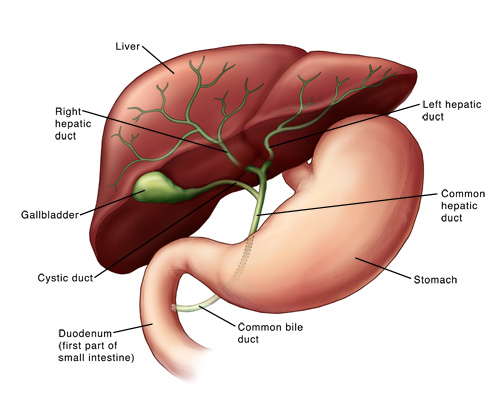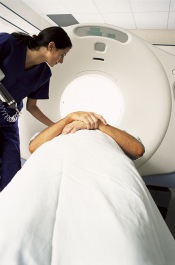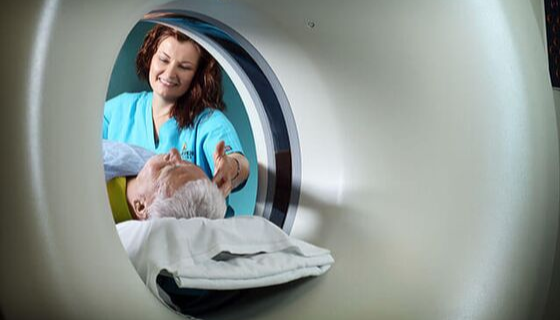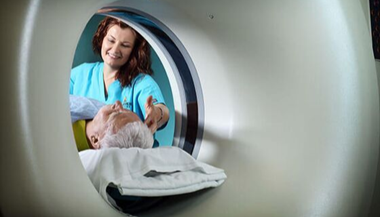Computed Tomography (CT or CAT) Scan of the Liver and Biliary Tract
What is a CT scan of the liver and biliary tract?
Computed tomography (CT scan or CAT scan) is a noninvasive diagnostic imaging procedure that uses a combination of X-rays and computer technology to produce horizontal, or axial, images (often called slices) of the body. A CT scan shows detailed images of any part of the body, including the bones, muscles, fat, and organs. CT scans are more detailed than standard X-rays.
In standard X-rays, a beam of energy is aimed at the body part being studied. A plate behind the body part captures the variations of the energy beam after it passes through skin, bone, muscle, and other tissue. While much information can be obtained from a standard X-ray, a lot of detail about internal organs and other structures is not available.
In computed tomography, the X-ray beam moves in a circle around the body. This allows many different views of the same organ or structure. The X-ray information is sent to a computer that interprets the X-ray data and displays it in a two-dimensional (2D) form on a monitor.
CT scans may be done with or without "contrast." Contrast refers to a substance taken by mouth and/or injected into an intravenous (IV) line that causes the particular organ or tissue under study to be seen more clearly. Contrast examinations may require you to fast for a certain period of time before the procedure. Your doctor will notify you of this prior to the procedure.
CT scans of the liver and biliary tract (the liver, gallbladder, and bile ducts) can provide more detailed information about the liver, gallbladder, and related structures than standard X-rays of the abdomen, thus providing more information related to injuries and/or diseases of the liver and biliary tract.
CT scans of the liver and biliary tract may also be used to visualize placement of needles during biopsies of the liver or during aspiration (withdrawal) of fluid from the area of the liver and/or biliary tract. CT scans of the liver are useful in the diagnosis of specific types of jaundice (yellowing of the skin and eyes as a result of certain conditions of the liver).
Other related procedures that may be used to diagnose liver and biliary tract problems include abdominal X-rays, liver scan, gallbladder scan, abdominal ultrasound, and abdominal angiogram.
The liver and biliary system

The liver is the largest internal organ in the body. This dark reddish brown organ is located in the upper right-hand portion of the abdominal cavity, beneath the diaphragm, and on top of the right kidney and intestines.
The wedge-shaped liver consists of 2 main lobes, both of which are made up of thousands of lobules. These lobules are connected to small ducts that connect with larger ducts to ultimately form the hepatic duct. The hepatic duct transports the bile produced by the liver cells to the gallbladder and duodenum (the first part of the small intestine).
The liver carries out many important functions, such as:
-
Making bile. Fluid that helps break down fats and gets rid of wastes in the body
-
Changing food into energy
-
Clearing the blood of drugs and other poisonous substances
-
Producing certain proteins for blood plasma
-
Regulating blood clotting
The biliary system consists of the organs and ducts (bile ducts, gallbladder, and associated structures) that are involved in the production and transportation of bile.
What are the reasons for a CT scan of the liver?
A CT scan of the liver and biliary tract may be performed to assess the liver and/or gallbladder and their related structures for tumors and other lesions, injuries, bleeding, infections, abscesses, unexplained abdominal pain, obstructions, or other conditions, particularly when another type of examination, such as X-rays, physical examination, and ultrasound is not conclusive.
A CT scan of the liver may be used to distinguish between obstructive and nonobstructive jaundice. Another use of CT scans of the liver and biliary tract is to provide guidance for biopsies and/or aspiration of tissue from the liver or gallbladder.
There may be other reasons for your doctor to recommend a CT scan of the liver and biliary tract.
What are the risks of a CT scan?
You may want to ask your doctor about the amount of radiation used during the CT procedure and the risks related to your particular situation. It is a good idea to keep a record of your past history of radiation exposure, such as previous CT scans and other types of X-rays, so that you can inform your doctor. Risks associated with radiation exposure may be related to the cumulative number of X-ray examinations and/or treatments over a long period of time.
If you are pregnant or suspect that you may be pregnant, you should notify your doctor. Radiation exposure during pregnancy may lead to birth defects.
If contrast dye is used, there is a risk for allergic reaction to the dye. Patients who are allergic to or sensitive to medications should notify their doctor. You will need to let your doctor know if you have ever had a reaction to any contrast dye, and/or any kidney problems. A reported seafood allergy is not considered to be a contraindication for iodinated contrast. If you are taking metformin/Glucophage or a related medication, you may be asked to stop taking it for at least 48 hours after receiving the contrast, as it may cause a condition known as metabolic acidosis, or an unsafe change in your blood pH.
There is a small chance of contrast material leakage from the IV line (known as contrast extravasation), which may cause swelling, stinging pain, or skin damage at the IV site.
Patients with kidney failure or other kidney problems should notify their doctor. In some cases, the contrast dye can cause kidney failure, especially if the person is dehydrated or has underlying kidney problems.
There may be other risks depending on your specific medical condition. Be sure to discuss any concerns with your doctor prior to the procedure.
Certain factors or conditions may interfere with the accuracy of a CT scan of the liver and biliary tract. These factors include, but are not limited to, the following:
-
Metallic objects within the abdomen, such as surgical clips
-
Presence of barium in the intestines from a recent barium study
-
Previous procedure using oral or IV contrast within a certain period of time, as the contrast may be broken down by the liver and excreted in the bile
How do I prepare for a CT scan?
If you are having a computed tomography angiography (CTA) or virtual colonoscopy with Johns Hopkins radiology, you will be given specific instructions when you make your appointment.
PRECAUTIONS: If you are pregnant or think you may be pregnant, please check with your doctor before scheduling the exam. Other options will be discussed with you and your doctor.
CLOTHING: You may be asked to change into a patient gown. If so, a gown will be provided for you. A locker will be provided to secure personal belongings. Please remove all piercings and leave all jewelry and valuables at home.
CONTRAST MEDIA: CT scans are most frequently done with and without a contrast media. The contrast media improves the radiologist's ability to view the images of the inside of the body.
-
Some patients should not have an iodine-based contrast media. If you have problems with your kidney function, please inform the access center representative when you schedule the appointment. You may be able to have the scan performed without contrast media or have an alternative imaging exam.
-
You will be asked to sign a consent form that will detail the risks and side-effects associated with contrast media injected through a small tube places in a vein called an intravenous (IV) line.
-
The most common type of CT scan with contrast is the double contrast study that will require you to drink a contrast media before your exam begins in addition to the IV contrast. The more contrast you are able to drink, the better the images are for the radiologist to visualize your digestive tract.
ALLERGY: Please inform the access center representative when you schedule your CT scan if you have had an allergic reaction to any contrast media. IV contrast will not be administered if you have had a severe or anaphylactic reaction to any contrast media in the past. If you had mild to moderate reactions in the past, you will likely need to take medication prior to the CT scan. These plans will be discussed with you in detail when you schedule your exam. Any known reactions to a contrast media should be discussed with your personal physician.
EAT/DRINK: If your doctor ordered a CT scan without contrast, you can eat, drink and take your prescribed medications prior to your exam. If your doctor ordered a CT scan with contrast, do not eat anything three hours prior to your CT scan. You are encouraged to drink clear liquids. You may also take your prescribed medications prior to your exam.
DIABETICS: Diabetics should eat a light breakfast or lunch three hours prior to the scan time. Depending on your oral medication for diabetes, you may be asked to discontinue use of the medication for 48 hours after the CT scan. If you have a CT scan with Johns Hopkins radiology, detailed instructions will be given following your examination.
MEDICATION: All patients can take their prescribed medications as usual.
Based on your medical condition, your doctor may request other specific preparation.
What happens during a CT scan?

CT scans may be performed on an outpatient basis or as part of your stay in a hospital. Procedures may vary depending on your condition and your doctor's practices.
Generally, a CT scan follows this process:
-
You may be asked to change into a patient gown. If so, a gown will be provided for you. A locked will be provided to secure all personal belongings.
-
Please remove all piercings and leave all jewelry and valuables at home.
-
If you are to have a procedure done with contrast, an intravenous (IV) line will be started in the hand or arm for injection of the contrast dye. For oral contrast, you will be given a liquid contrast preparation to swallow. In some situations, the contrast may be given rectally.
-
You will lie on a scan table that slides into a large, circular opening of the scanning machine. Pillows and straps may be used to prevent movement during the procedure.
-
The technologist will be in another room where the scanner controls are located. However, you will be in constant sight of the technologist through a window. Speakers inside the scanner will enable the technologist to communicate with and hear you. You may have a call button so that you can let the technologist know if you have any problems during the procedure. The technologist will be watching you at all times and will be in constant communication.
-
As the scanner begins to rotate around you, X-rays will pass through the body for short amounts of time. You will hear clicking sounds, which are normal.
-
The X-rays absorbed by the body's tissues will be detected by the scanner and transmitted to the computer. The computer will transform the information into an image to be interpreted by the radiologist.
-
It will be important that you remain very still during the procedure. You may be asked to hold your breath at various times during the procedure.
-
If contrast dye is used for your procedure, you may feel some effects when the dye is injected into the IV line. These effects include a flushing sensation, a salty or metallic taste in the mouth, a brief headache, or nausea and/or vomiting. These effects usually last for a few moments.
-
You should notify the technologist if you feel any breathing difficulties, sweating, numbness, or heart palpitations.
-
When the procedure has been completed, you will be removed from the scanner.
-
If an IV line was inserted for contrast administration, the line will be removed.
While the CT procedure itself causes no pain, having to lie still for the length of the procedure might cause some discomfort or pain, particularly in the case of a recent injury or invasive procedure such as surgery. The technologist will use all possible comfort measures and complete the procedure as quickly as possible to minimize any discomfort or pain.
What happens after a CT scan?
If contrast dye was used during your procedure, you may be monitored for a period of time for any side effects or reactions to the contrast dye, such as itching, swelling, rash, or difficulty breathing.
If you notice any pain, redness, and/or swelling at the IV site after you return home following your procedure, you should notify your doctor as this could indicate an infection or other type of reaction.
Otherwise, there is no special type of care required after a CT scan of the liver and biliary tract. You may resume your usual diet and activities unless your doctor advises you differently. Your doctor may give you additional instructions after the procedure, depending on your particular situation.



